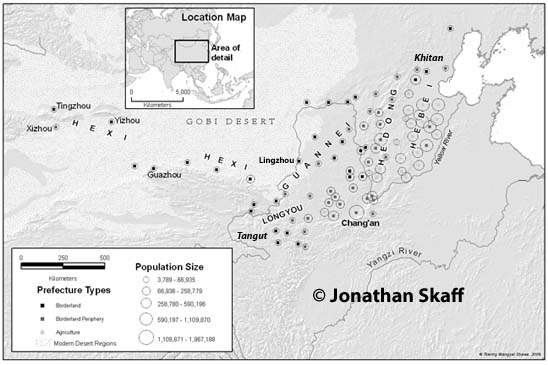
*Liao (Kitan/Khitan) Dynasty, 907-1125
*Xi Xia {Tangut} Dynasty, 1038-1227
Barbaric invaders and oppressors
Kitan/Khitan Liao & Tangut Xi Xia
Pastoral nomadism
Chinese practicing agriculture
Source of wealth
Song population 20 times larger
Only a few imperial Chinese dynasties lasted longer
Liao {Kitan}, 907- 1125
Xi Xia {Tangut}, 1038-1227
Han, Tang, and Song
Longer-lasting than Xianbei (Särbi) and Mongolian Dynasties
Northern Wei {Tabgach}, 386-534
1st Türk Empire (552-630)
2nd Türk Empire (682-742)
Uighur Empire (744-840)
Pastoral nomadic people
W. Manchuria homeland (Liao River)
Mongolic language
Repetition of late Han-Northern Dynasties pattern
Tang or Turk Uighur vassals, 7th-8th centuries
Kitan contingent in An Lushan’s forces, 755

Electedd tribal leader, 907
Bypassed tribal councils 910, 913
Emperor Taizu (r. 916-926)
Great Kitan Dynasty founded
Wife of Abaoji
Held power, 926-47
Mom of Taizong r. 926-47
Took possession of “16 Prefectures,” from Later Jin Dynasty, 938
Liao Dynasty Founded
Personal talent of Abaoji
and Empress Chunqin
Exploit power vacuum
China disunited since late Tang 880s
Mongolia in disarray since fall of Uighur Turks in 840s
Multiple capitals
Dual administration
Great Kitan in north
Great Liao in south
Multiple capitals
N. Song-Liao wars 979-1004
Liao treaty with Northern Song, 1005
Liao forces withdraw
Defined border along southern “16 Prefectures”
Annual Song gifts
200,000 bolts of silk
100,000 ounces (4,000 kilos) of silver
Emperors address each other as brothers
1. What is the purpose of a capital city in the traditional China and modern senses?
What were the Kitan capital cities like?
2. Why do some scholars, such as Kang Peng on page 101, deny that the five cities should be considered capitals?
Hu Lin admits that the first “August Capital was little more than a ram-earthed enclosure with sparse buildings permanent inhabitants. It was thus more emphatically a symbolic representation of empire rather than a functioning administrative center” (Fig. p. 104, quote p. 105, 3rd para). Why does the author argue that it should be considered capital city?
3. According to the author, what was the purpose of the four later cities?
4. Do you agree with the author’s argument that the Kitan’s five cities should be considered capitals?
Can a city be considered a capital if administrators are not stationed there?
Could the author’s argument be strengthened if he provide evidence of where economic, administrative, or ritual activities took place in the Liao Empire?
Pastoral nomads
SE Qinghai-SW Gansu
Tibeto-Burmese language
Tuoba leading clan
Migrated to Ordos Region under Tang
Modern Ningxia
Li surname
Li Jiqian (r. 982-1004)
Unified Tangut and non-Tangut tribes
Li Deming (r. 1004-32)
Expanded territory to the NW
*Li Yuanhao (r. 1032-48)
Educated in Tibetan and Chinese
Founded Xi Xia Dynasty
Enforced national hairstyle
Script for Tangut language
Translations from Chinese and Tibetan
Established Chinese style dynasty
Emperor of “Great Xia”
“Great State of White and High”
Changed name to Weiming Yuanhao
Blood oath with military aristocrats
Buddhism as state religion
Buddhist State Preceptor
Translation projects
"State Preceptor Bai Zhiguan presiding sutra translation with the emperor Huizong and Dowager Empress Liang in attendance," ca. 1085
Song win battles and lose war
Peace treaty of 1044
Emperors address each other as brothers
Annual Song gifts
200,000 bolts of silk
100,000 ounces (4,000 kilos) of silver
Li Yuanhao is Song “official”
Annual Song gifts
72,000 ounces (2,880 kilos) of silver
153,000 bolts of silk
Shipments of tea